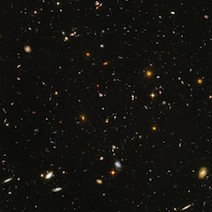The cosmological principle is a fundamental notion of modern cosmology. In a few words, our position in the Universe has nothing special: wherever you are in the Universe, when you observe it, what you see is the same everywhere, and the laws of physics are the same everywhere. The Universe is homogeneous and isotropic.
Many observations have confirmed this idea, for example the distribution of galaxies is more or less the same everywhere, no matter where you look.
However, in the recent years, some cosmologists started to have doubts about the truthfulness of this principle. More precisely, it looks like there is an anisotropy on the cosmic scale: the acceleration of the expansion of the Universe is not the same in every direction.

In 1998, cosmologists discovered that the expansion of the Universe was accelerating, thanks to a particular kind of stars, type IA supernovae. Rong-Gen Cai and Zhong-Liang Tuo from the Chines Academy of Sciences in Beijing re-analyzed the data of 557 type IA supernovae, and they observed that the acceleration of the expansion was faster in a given direction, towards the constellation Vulpecula in the northern hemisphere. It is interesting to note that this anisotropy has apparently been observed in the cosmic microwave background, too.
As the scientists mention in their paper, previous analyses of type IA supernovae data haven’t found any evidence for significant anisotropies, and many observations are supporting the idea of a homogeneous and isotropic Universe. Further studies are necessary before coming to any conclusion.
Finally, it is important to realize that the cosmological principle is one of the pillars of modern cosmology. If it ever turns out to be wrong, it is needless to say it’ll come as a small huge bombshell…
Reference
Rong-Gen Cai, et al. “Direction dependence of the acceleration in type Ia supernovae.” arXiv:1109.0941v2

